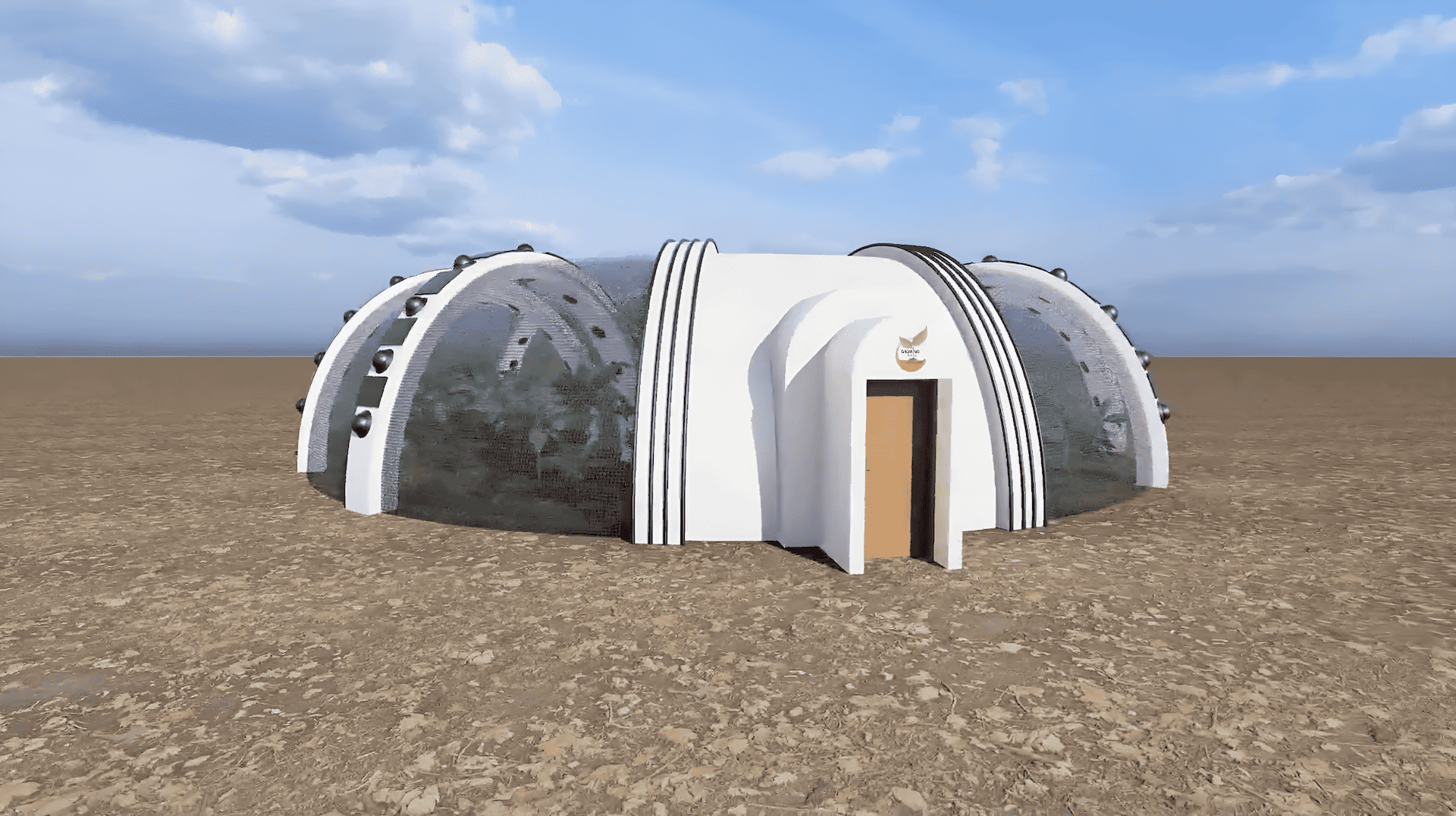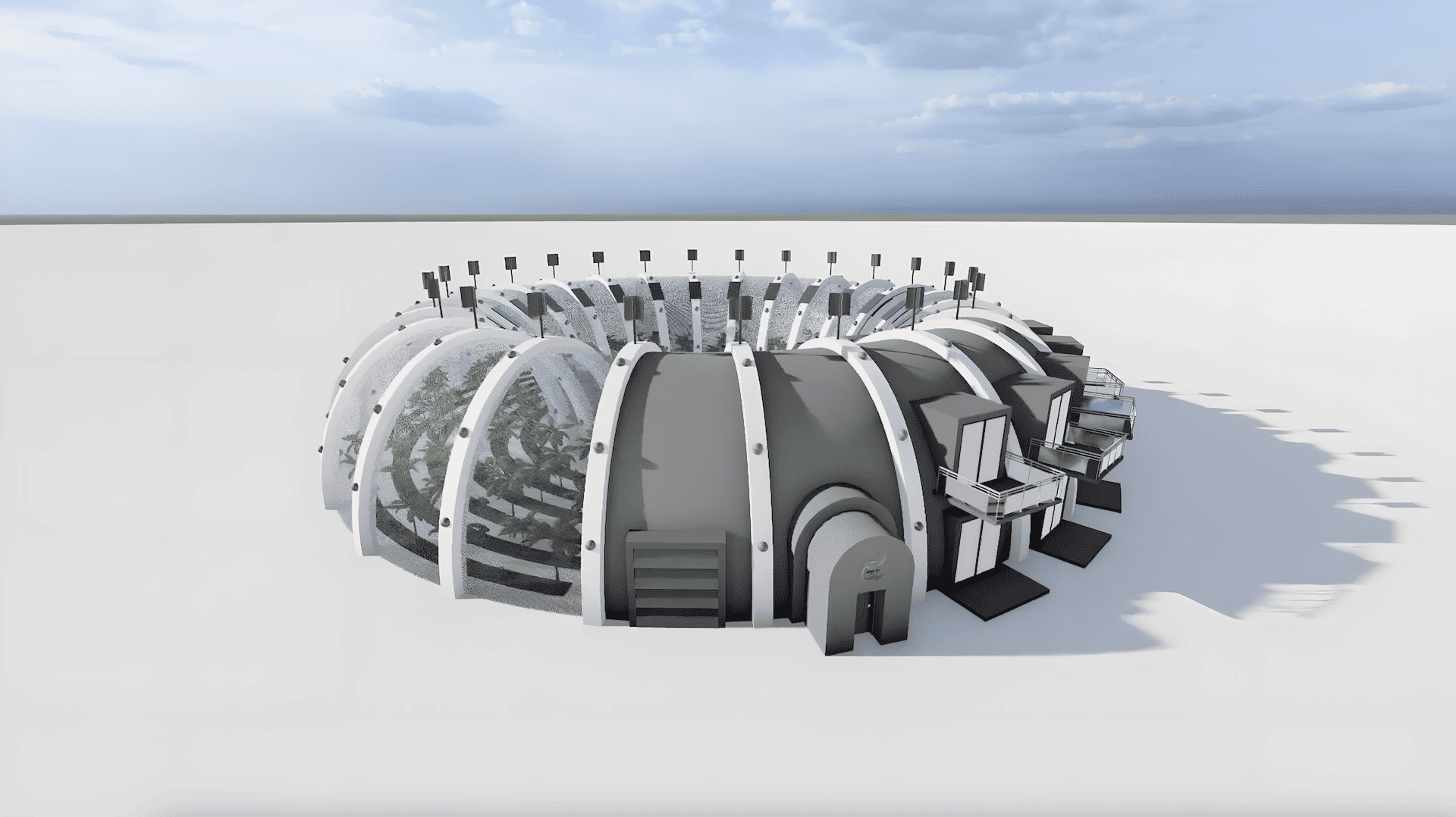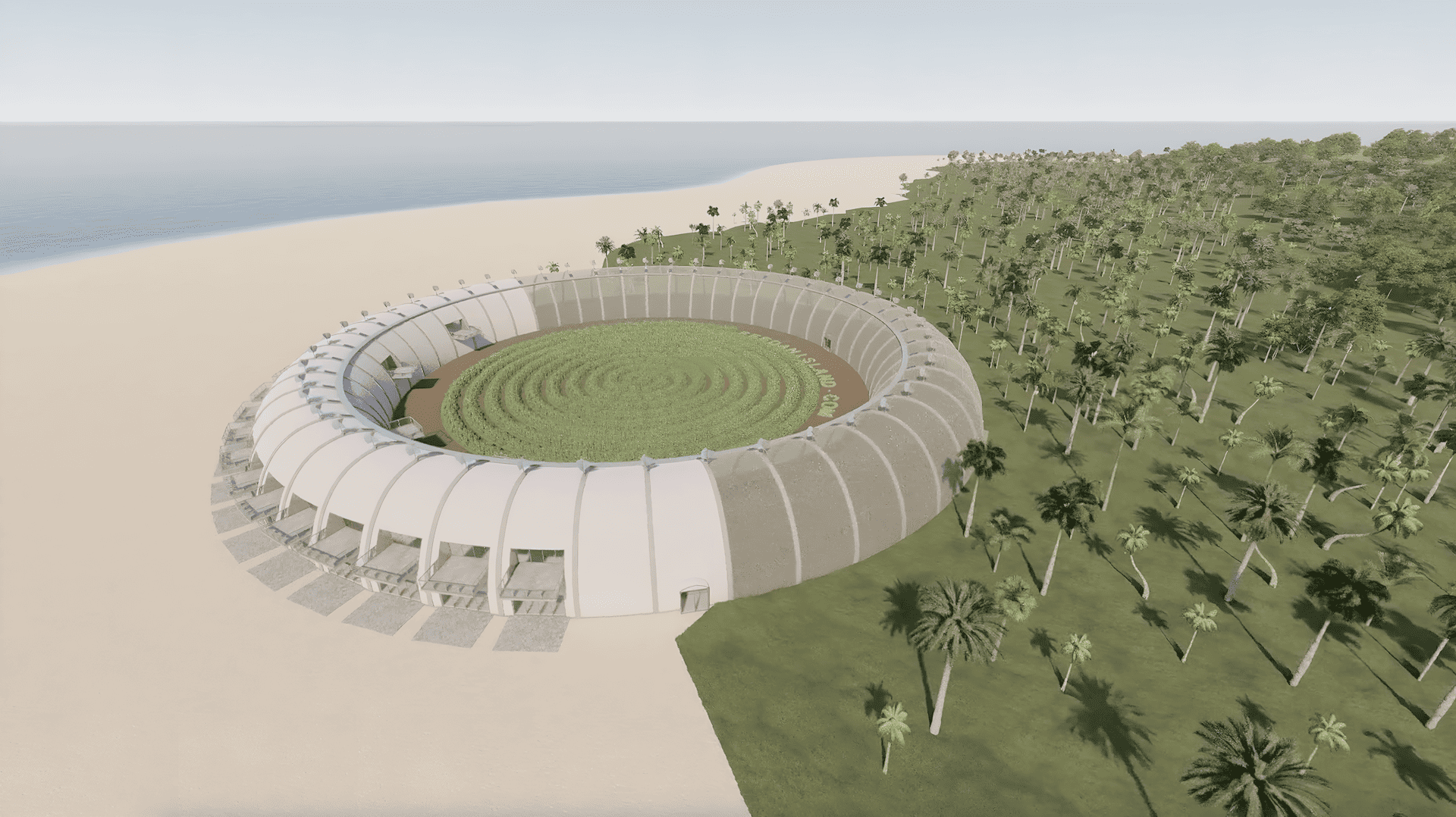Food Habitats: Food security and energy independence anywhere, everywhere
Feed An Island Food Habitats combine residence with food production in an island setting. Their unique design provides protection for both structure and plant from the elements. The sectioned torus shape of the structure deflects excessive wind creating a calm zone at the center of the habitat. In one version of the habitat, the calm zone plants grow in a geometric spiral and in another, a 30-foot circular tank grows fish. Food Habitats are designed to operate “off-the-grid” generating electrical power from the wind and sun. A shaded archway permits year-round production of sun-delicate plants like spinach and lettuce. One or more residences occupy a portion of the circular arch that encompasses the calm zone. A single residence habitat could be used to provide accommodation for operators of the farm. Larger Habitats with multiple residences could be offered as a temporary stay in an eco-style resort or sold as a qualifying investment for an island second residence and/or passport program.
Crop Circle Food Habitats
The circular design prompts the name Feed An Island, which coincides with the brand name of the agricultural technologies used by the structure to grow plants. All types of plants can be grown inside and/or outside the habitat. In larger habitats, sun-loving plants are grown in a circular courtyard surrounded by covered curved archways that grow plants in semi-shade. Crop Circle Irrigators imbedded in soil grow plants using 90% less fertilizer and water and yields are twice that of a farm field acre.
Above Ground Single Residence Food Habitats
Single Residence Food Habitats provide accommodation for a crew or family that “works” the farm full-time for profit. A raised deck at the center of the habitat surrounds a 10-foot-deep fish tank. Storage, mechanical and a curved shelving area for growing mushrooms are provided under the deck. A shaded archway surround provides protection for sun delicate plants.
Each of the 20 support arches is equipped with a wind turbine mounted at its apex, contributing to a sustainable and renewable energy system designed to power the habitat efficiently. These wind turbines harness the natural energy of the wind, ensuring a consistent source of clean energy. In addition to wind power, solar panels can also be integrated into the system, providing a complementary renewable energy source. This dual energy approach maximizes energy generation while minimizing reliance on external power sources.
The Single Residence Food Habitat itself requires a minimum of half an acre of land for the structure, making it a compact yet self-sufficient living solution. For those who wish to grow plants beyond the confines of the habitat, additional land is necessary to support agricultural activities. There are two innovative and efficient methods for cultivating plants outside the habitat.
The first method involves planting in concentric circles around the structure, creating a visually appealing and organized layout that optimizes land use. This design allows for easy irrigation, efficient use of space, and simplified maintenance. The circular arrangement also fosters a sense of harmony with nature, aligning with the principles of sustainable and regenerative agriculture.
The second method consists of planting in radiating rows that extend outward from the habitat like spokes on a wheel. This design maximizes accessibility to crops, facilitates irrigation channels, and provides clear pathways for tending to the plants. The radiating layout also enables scalability, as rows can be extended or added to accommodate larger-scale cultivation needs. Radial row growing is an ideal cultivation method for blueberry, gooseberry and blackberry bushes that generally require more room between rows.
Both planting methods are designed to integrate seamlessly with the habitat’s renewable energy systems and sustainable living ethos, providing residents with the tools to live in harmony with nature while producing their own food. These innovative solutions not only enhance food security but also contribute to a more sustainable and self-reliant lifestyle.
Below Ground Single Residence Food Habitats
Our smallest Single Residence Food Habitat features an underground residence, offering a unique and sustainable approach to living. By situating the living quarters below ground, this design provides multiple advantages, making it both efficient and environmentally friendly.
One significant benefit of an underground residence is the optimal use of above-ground space. With the living area moved below the surface, nearly the entire span of the covered archway is available for cultivating food. This maximizes the productive capacity of the habitat, allowing residents to grow a greater variety and quantity of crops without needing additional land. The design supports high-yield, sustainable food production while maintaining a compact footprint.
Another key advantage is the natural cooling effect provided by the surrounding soil. The native soil acts as a natural insulator, maintaining a stable temperature within the underground residence. This reduces the need for artificial cooling systems, significantly lowering energy consumption and enhancing the habitat's overall sustainability. In hot climates, this natural cooling feature provides a comfortable living environment while reducing costs associated with air conditioning.
Additionally, an underground residence offers increased protection from environmental elements. The subterranean design shields the home from extreme weather conditions, such as strong winds, heavy rains, or even natural disasters like hurricanes. This adds an extra layer of safety and durability to the habitat, ensuring long-term resilience.
Privacy is another benefit of the below-ground structure. With the residence hidden beneath the surface, the habitat blends seamlessly with its surroundings, offering a discreet and tranquil living space. This can be particularly appealing for those seeking a peaceful and secure environment.
Lastly, the integration of an underground residence with renewable energy systems, such as the wind turbines and solar panels mounted on the arches, creates a holistic and self-sufficient lifestyle. The habitat is designed to operate off-grid, combining food production, energy efficiency, and sustainable living in one innovative solution.
In summary, the Below Ground Single Residence Food Habitat provides a compact yet highly functional living solution that maximizes food production space, leverages natural cooling, and ensures protection and privacy—all while maintaining harmony with the surrounding environment. This design represents a forward-thinking approach to sustainable living, ideal for those seeking efficiency and resilience in a changing world.
Multiple Residence Food Habitats
Multiple Residence Food Habitats are designed to serve as eco-friendly temporary stay resorts or permanent residential accommodations. These innovative structures blend sustainable living with community-driven agriculture, creating a harmonious balance between humans and nature.
The largest of these Food Habitats requires at least two acres of land, with additional space available if crops are to be cultivated around the structure’s perimeter. Similar to Single Residence Food Habitats, the agricultural design incorporates concentric circles or radiating rows, which extend outward, promoting efficient land use and maximizing food production. At the heart of the Habitat lies a planted spiral, encompassing an acre of land. This spiral serves as the focal point of the community, surrounded by a thoughtfully designed common area where residents can connect with nature and one another. This area offers a serene environment for residents to engage in activities such as plant tending, harvesting food for meals, or simply wandering through the spiral for relaxation and mindfulness.
A select few residences within the Habitat are designed with private decks facing the courtyard, providing unparalleled views of the vibrant spiral garden and communal activities. These residences invite residents to immerse themselves in the dynamic energy of the community while enjoying moments of private serenity.
A Multi-functional Courtyard for Sustainability and Abundance
The central spiral garden doubles as a functional farm, producing fresh, organic food during the day to nourish hundreds of residents and visitors on the island. Beyond the spiral, an innovative covered archway houses additional crops, increasing the Habitat’s food production capabilities to feed even more people.
Energy and Resource Innovation
The Habitat integrates cutting-edge sustainable technologies, including:
- Arch-mounted wind turbines and solar panels that generate renewable energy to power the community
- Solar-heated piping systems mounted on the arches that provide hot water efficiently
- A subterranean seed bank corridor, ensuring the preservation of diverse plant species. This seed bank functions as a vital resource for the entire island, safeguarding the genetic diversity necessary for future agricultural resilience
Redefining Community Living
These Multiple Residence Food Habitats offer more than just accommodation; they are a transformative lifestyle experience. They provide a model for self-sufficient, eco-conscious communities, where residents can embrace the simplicity of living off the land while enjoying modern comforts.
The vision of Food Habitats aligns with a sustainable future, where housing and agriculture work in unison to support thriving, resilient communities that live in harmony with nature. This blueprint serves as a prototype for islands and regions seeking innovative solutions to food security, energy independence, and community well-being.


